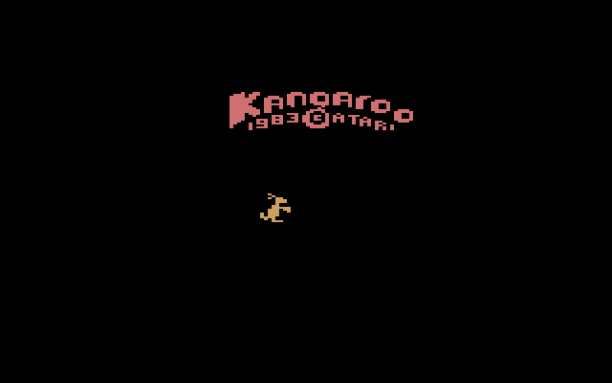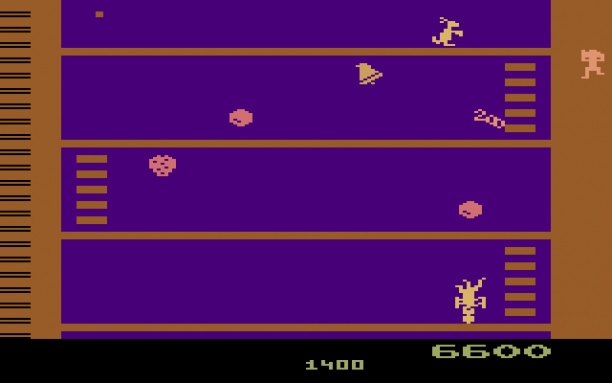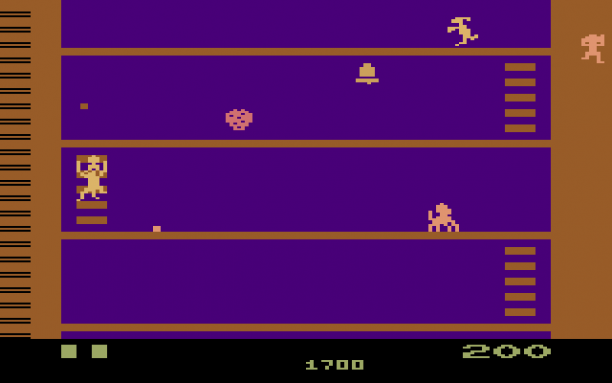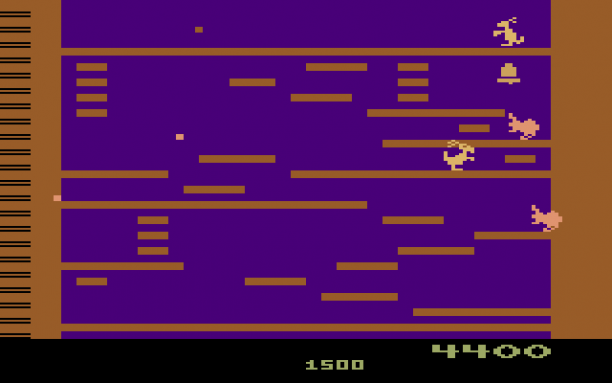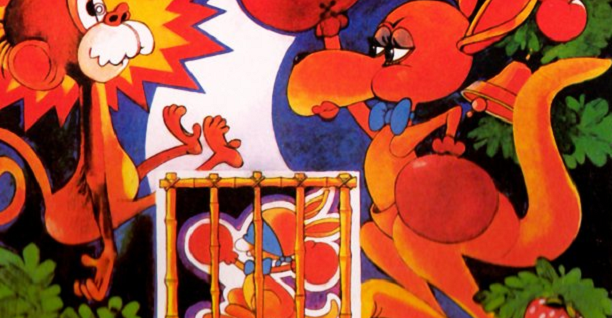
Pixel Gallery
Kangaroo
Retro Platforms: Arcade, Atari 2600, Atari 5200, Atari 8-bit
Platform Reviewed: Atari 2600
It’s an objective fact a popular opinion that kangaroos are pretty awesome animals, and the reasons for this extend beyond just their majestic appearances: they’re also excellent jumpers, they have sophisticated social behaviors, and they can even be impressive boxers! Being marsupials, kangaroos are closely related to wallabies and koalas, which are also undeniably awesome frequently liked creatures. With regard to physical traits, kangaroos additionally have adaptive feet for leaping, long tails for careful balancing, and female kangaroos also have pouches to hold their children. Several kangaroo abilities are also reflected in the first arcade game to ever feature a playable kangaroo, simply known as Kangaroo, and its gameplay involves helping a mother kangaroo rescue her child from vicious monkeys. But is the game well-designed, and does the Atari 2600 version play well?
Graphics
Even though the Atari 2600 has limited visual potential, it’s fairly disappointing that Kangaroo doesn’t really attempt to have much of a real background: there’s a single blue layer, with no additional textures to add any depth to it. Floors and ladders are also limited in scope, with everything being the same color; this lack of variety ends up feeling kind of uninspired. Thankfully, the ladders are practically distinguishable from a gameplay perspective: they have notably skinnier widths, although the second stage has one random and awkward exception to this. Although the stage design is very limited artistically, there are creative background events that I really like: enemies climb down walls before jumping into the stages, which adds to the graphical complexity. There are some additional details I like too: the actual colors used serve as great complements to one another, and the characters are elaborately drawn with multiple bends in their arms and legs.
The animation is pretty solid, and there are various movements without noticeable lag; the characters flicker at times, but there’s never any perceived invisibility. On the top of the screen, our main heroine’s child bounces back and forth, and although the walking is fixed, it’s a nice detail that makes the joey feel lively instead of just being a lifeless object. As for the playable character, the mother makes short jumps as she moves left and right, and I honestly find the movements cute and cheerful to watch. Additional kangaroo actions include sudden punches, back-view ladder climbing, and high leaps; these animate smoothly too, although a weird tilt effect happens at the top of jumping. Projectiles from monkeys and apples aren’t particularly choppy, although I find the latter to be incredibly basic in appearances: the apples are literally just rectangles, but at least they move properly. Other things to note are some surprisingly elaborate collectible fruits, and some strange monkey portrayals: the monkeys look convincing as they climb, but when they just walk around, they look more like large spiders.
Audio
There isn’t continuously playing music, which is totally expected due to hardware limitations, but that doesn’t mean the developers ignored having jingles altogether: unique samples play when starting a stage, hitting a bell, and rescuing the joey. Impressively, these little tunes are adapted from existing classical songs, including American Patrol, Westminster Quarters, and Oh! Susanna; the music makes the presentation livelier, and it definitely helps that the audio sounds pleasant to the ears. Additionally, most gameplay-related movements have their own looping sound effects: a cute jingle plays while climbing ladders, jumps have lively feedback, and there are different sounds for various types of player deaths, among other examples. There’s an impressive amount of audio variety in a game from this era; everything’s really upbeat as well! The only criticisms I really have with the audio are nitpicks: projectiles are silent, and the sounds for ducking and higher leaping have static elements.
Gameplay
The main objective of Kangaroo, similar to the original Donkey Kong, involves moving up a series of platforms in order to rescue someone, although there are some differences that make the games fairly unique. Both arcade games have time limits in each stage, but Kangaroo has a slightly larger focus on jumping, both for avoiding projectiles as well as leaping between logs to gain distance. Additionally, instead of using items to defeat your enemies, Kangaroo lets you directly punch enemy monkeys via the controller’s button; the mother kangaroo will protect her child, and anyone in her way shall face her wrath! Besides simply surviving to the end, there are also various ways to earn points, including defeating monkeys, gaining time bonuses (from finishing levels early), and hitting bells that spawn fruit further back in the stages. The movement’s well-animated, and the controls feel very responsive, although there are some accuracy issues with certain platform jumps.
The enemy involvement makes the gameplay complex, and it does so in a fun way that adds engaging (but not unfair) challenge. Monkeys climb down the right of the screen, and running into the mischievous critters takes away a life; strangely, this collision also kills the monkey. You can either evade the monkeys, or you can carefully navigate toward them in order to fire punches, which defeats the monkey and awards you with points; it takes a while for a new monkey to spawn too, so this is a strategy to consider. When monkeys stay on the screen too long, they throw apples as projectiles; these have to be jumped over if tossed lowly, ducked under if tossed highly, and they can be either leaped over or carefully punched (for points) when thrown at mid-level. I find the projectiles add rapid and fun decision-making to the gameplay, as you have to consider pros and cons for many things: do you risk safety for more points, how quickly might you advance, and should you just deck it for the end?
Another obstacle comes in the form of a bouncing apple that spawns on the top of the screen, although the intervals for its appearances seem to be slightly randomized: this apple ricochets along a platform until you appear directly underneath it, at which point it falls straight down until it hits you or falls off the screen. I typically run away from it, but you can also earn points if you carefully punch the apple at the right time. Coupling this fun mechanic with the enemies, it adds a need to properly pace yourself onto an existing need to pay attention to enemy approaches. I do dislike one thing about the bouncing apple though: if you’re climbing a ladder near the left of the screen and the apple spawns during that, then there’s not enough time to move out of the way, which realistically means you need to lure the apple away before attempting such a climb. It basically makes you decide between arbitrarily waiting versus taking a luck-based risk of climbing the ladder, neither of which seems particularly fair; however, this isn’t too frequent, and it’s not a concern if the apple’s elsewhere on the screen.
With the addition of fruits that you can deliberately spawn up to several times, Kangaroo also introduces a balance system of mid-level points versus end-level time bonuses: this lets you decide how to pursue a high score, yet also gives players who just want to beat the three levels a choice to focus on that as well. Since higher-valued fruits additionally appear in later stages, there’s another thing to consider, and ringing the bell to spawn more fruit seems like something you’re encouraged to do at least once. The stages also have notably different layouts: the first has no gaps to jump over, the second plays like an ascending staircase that requires frequent leaps, and the third splits into multiple directions that add some non-linearity. Difficulty-wise, the second level seems to be the hardest, and the manual mentions this as well, which I honestly find odd in terms of progression. If you finish all three levels, which is a fun goal on its own, then the stages also loop with a higher difficulty.
One mechanic I have mixed opinions on is the jumping itself. It works well when you’re just walking along platforms and leaping over enemy projectiles, and the fact that you can choose to move forward or cease momentum mid-air adds a decent amount of flexibility to your controls. However, I find it pretty tricky to properly execute complete jumps between ascending platforms that have pits between one another, and it’s not always clear when the best time to start a leap is; part of this might come from jumping being initiated by a direction, which is expected given the controller’s single-button limitation, but it’s still awkward at times. Despite this, I’m still glad to have kangaroo jumping in the game, and it’s certainly fun to mess around with; the timing issues are also only present in the second level, as the third level’s gaps seem shorter in width.
A common feature in Atari 2600 games is the ability to set hardware switches to unlock different game modes, such as removing certain obstacles. Those switches unfortunately don’t do anything in Kangaroo, although it’s made up for by the game having multiple difficulty options: a more advanced mode starts with the monkeys throwing projectiles at a faster speed, and this definitely increases the challenge. Additionally, there’s a two-player mode, where both players take turns to reach a higher score. Speaking of high scores, I do have a nitpick in that Kangaroo kicks back to the title screen as soon as the game ends, so make sure you record your score before this happens; aside from that though, the extra features are great to have, and I like them!
Conclusion
Kangaroo isn’t without its issues, but those problems are fairly minor compared to the game’s fun and cheerful presentation. Some aspects of the second level’s stage design could be improved, and the bouncing apple isn’t always a fair mechanic, but everything else about the gameplay is generally solid: monkeys are satisfying to defeat, level progression is entertaining, and there’s a surprising amount of complexity in deciding how to earn your points. In terms of graphics, the backgrounds might be lacking, but the in-game events are generally well-drawn; the sprites animate nicely too, and the characters provide a welcome quirkiness. Add some really creative and varied sound design, as well as multiple difficulty options, and you have a really engaging arcade game that I would definitely recommend buying! And come on, it even stars a freaking kangaroo!
